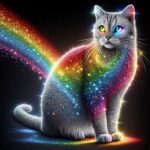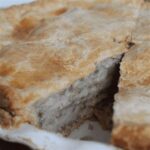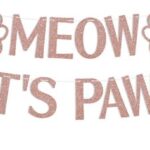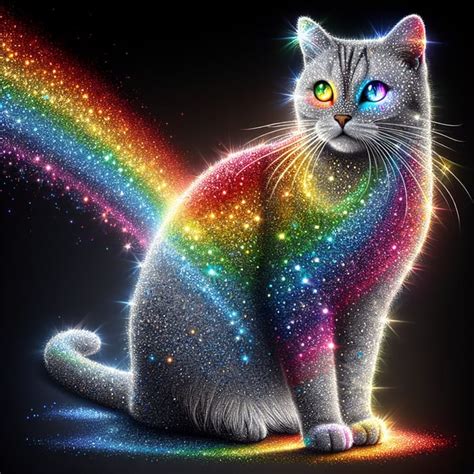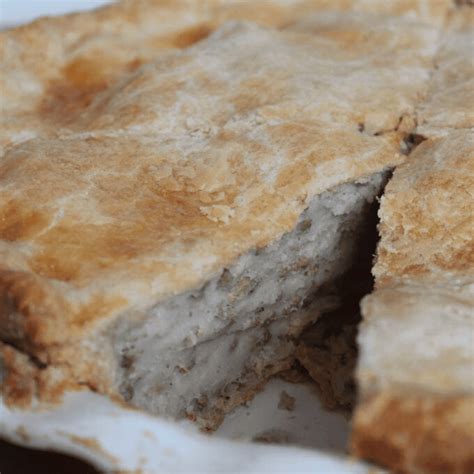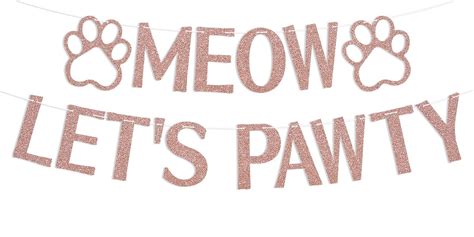
A curious cat’s playful exploration of cosmetic glitter resulted in a sparkly spectacle that has captured the internet’s attention, turning a potential cleanup nightmare into a viral sensation. When Ashley Nicole, the cat’s owner, discovered her feline friend covered head-to-toe in shimmering glitter, she initially braced for a tedious cleaning task. However, the resulting images of the glitter-coated cat, affectionately nicknamed “Glitter Cat,” proved too amusing not to share. The incident has resonated widely on social media, sparking humorous reactions and highlighting the unpredictable antics of household pets.
Ashley Nicole, a mother active on TikTok, recounted the incident that transformed her ordinary feline companion into an extraordinary “Glitter Cat.” She had been organizing her craft supplies when her cat, drawn by the shiny allure of cosmetic glitter, seized the opportunity for an impromptu investigation. The glitter, stored in a container that was not entirely sealed, became an irresistible temptation for the inquisitive feline.
“I came back, and she was covered in glitter,” Ashley Nicole explained in her TikTok video. Her initial reaction was a mix of dismay and amusement, realizing the extent of the glitter explosion. Instead of immediately attempting to remove the glitter, Ashley Nicole decided to capture the moment, resulting in a series of photos and videos showcasing her cat’s dazzling transformation.
The resulting images and videos quickly went viral, amassing millions of views and attracting widespread media attention. Social media users were captivated by the cat’s comical appearance, with many praising Ashley Nicole’s lighthearted response to the situation. Comments ranged from humorous observations about the cat’s newfound sparkle to sympathetic remarks about the inevitable challenge of cleaning up the glitter.
The incident underscores the inherent curiosity of cats and their propensity for exploring their surroundings, often leading to unexpected and amusing situations. It also highlights the power of social media to transform ordinary moments into viral sensations, connecting people through shared laughter and relatable experiences.
Ashley Nicole’s experience serves as a reminder of the unpredictable nature of pet ownership and the importance of maintaining a sense of humor when dealing with unexpected messes. While the cleanup process may have been daunting, the resulting viral fame and shared amusement made the glitter incident a memorable and positive experience for both Ashley Nicole and her now-famous feline companion.
The unexpected popularity of “Glitter Cat” has also prompted discussions about pet safety and the potential hazards of leaving potentially harmful substances within reach of animals. While cosmetic glitter is generally considered non-toxic, it can still pose a risk if ingested or inhaled. Pet owners are reminded to store glitter and other craft supplies in secure containers and to supervise their pets when engaging in activities that involve potentially hazardous materials.
The “Glitter Cat” incident has not only provided a moment of levity but has also served as a reminder of the unique bond between humans and their pets, highlighting the joy and amusement that animals bring to our lives. The incident also spurred online discussions about glitter’s impact on the environment and potential alternatives.
In-Depth Analysis and Context
The story of “Glitter Cat” is a compelling example of how a seemingly mundane event can capture the internet’s collective imagination. Several factors contributed to the viral success of this particular incident.
Firstly, the visual appeal of a cat covered in glitter is undeniably striking. The unexpected juxtaposition of a common household pet with a shimmering, glamorous substance created a visually arresting image that immediately caught the eye. The humor derived from the cat’s unintentional transformation, combined with Ashley Nicole’s amused reaction, resonated with a wide audience seeking lighthearted entertainment.
Secondly, the relatability of the situation played a significant role in the story’s viral spread. Many pet owners can empathize with the experience of dealing with unexpected messes and mischievous animal antics. The “Glitter Cat” incident serves as a reminder of the unpredictable nature of pet ownership and the importance of maintaining a sense of humor when faced with such challenges.
Thirdly, the power of social media to amplify ordinary moments should not be underestimated. Ashley Nicole’s decision to share the images and videos of her glitter-covered cat on TikTok proved to be a catalyst for the story’s rapid dissemination. The platform’s algorithm, combined with the story’s inherent appeal, ensured that it reached a vast audience, triggering a chain reaction of shares, comments, and media coverage.
The “Glitter Cat” phenomenon also underscores the evolving role of pets in contemporary society. Animals are increasingly viewed as integral members of the family, providing companionship, emotional support, and entertainment. The internet has become a platform for sharing pet-related content, fostering a sense of community among animal lovers and celebrating the unique bond between humans and their furry, feathered, or scaled companions.
Furthermore, the incident has prompted discussions about responsible pet ownership and the importance of safeguarding animals from potential hazards. While cosmetic glitter is generally considered non-toxic, it can still pose a risk if ingested or inhaled. Pet owners are reminded to exercise caution when using glitter and other craft supplies around animals, ensuring that these materials are stored securely and that pets are supervised during activities that involve potentially hazardous substances.
Beyond the immediate amusement, the “Glitter Cat” story also touches upon broader themes related to consumerism and environmental awareness. Glitter, often made from microplastics, has been identified as a potential source of pollution. The widespread use of glitter in cosmetics, crafts, and other applications has raised concerns about its long-term impact on ecosystems and human health. The “Glitter Cat” incident may serve as a reminder to consider the environmental implications of everyday products and to explore more sustainable alternatives.
The viral success of “Glitter Cat” is a testament to the power of humor, relatability, and social media in shaping contemporary culture. The story has provided a moment of levity and shared amusement, while also prompting discussions about pet safety, responsible consumerism, and the evolving role of animals in our lives.
Expanded Context and Background Information
To fully appreciate the “Glitter Cat” phenomenon, it is helpful to consider the broader context of internet culture and the factors that contribute to a story’s virality. Several elements typically align to propel a particular piece of content into the digital spotlight.
Novelty and Uniqueness: Content that is unexpected, unusual, or visually striking often has a greater chance of going viral. The image of a cat completely covered in glitter certainly fits this description. The unusual combination of a common pet with a glamorous substance created a visually arresting image that immediately captured attention.
Humor and Entertainment Value: Content that is funny, entertaining, or heartwarming tends to resonate with a wider audience. The “Glitter Cat” story is inherently humorous, stemming from the cat’s unintentional transformation and the owner’s amused reaction. The lighthearted nature of the incident made it easily shareable and appealing to a broad range of viewers.
Relatability and Emotional Connection: Content that taps into universal emotions or experiences often has a greater impact. Many pet owners can relate to the experience of dealing with unexpected messes and mischievous animal antics. The “Glitter Cat” incident serves as a reminder of the unpredictable nature of pet ownership and the importance of maintaining a sense of humor when faced with such challenges.
Shareability and Social Currency: Content that is easy to share and that enhances the sharer’s social image is more likely to go viral. The “Glitter Cat” story is easily shareable across various social media platforms. Sharing the story could be seen as a way to signal one’s sense of humor, love for animals, or appreciation for lighthearted entertainment.
Timeliness and Trend Alignment: Content that aligns with current trends or cultural conversations may gain more traction. The “Glitter Cat” incident occurred within a broader context of pet-related content dominating social media feeds. The story tapped into the existing demand for animal-related entertainment, increasing its chances of going viral.
Furthermore, the “Glitter Cat” story can be analyzed through the lens of meme culture. A meme is an idea, behavior, or style that spreads from person to person within a culture. Internet memes often take the form of images, videos, or phrases that are shared and adapted online. The “Glitter Cat” incident has the potential to evolve into a meme, with users creating variations, remixes, and parodies of the original content.
The spread of memes can be influenced by various factors, including:
Simplicity and Replicability: Memes that are easy to understand and replicate are more likely to gain traction. The “Glitter Cat” concept is relatively simple and can be easily adapted into various formats.
Humor and Irony: Memes that are funny, ironic, or satirical often resonate with a wider audience. The humor inherent in the “Glitter Cat” story makes it a suitable candidate for meme creation.
Relatability and Shared Experience: Memes that tap into shared experiences or emotions often have a greater impact. Many people can relate to the experience of dealing with unexpected messes or the joy of owning a pet.
Longevity and Adaptability: Memes that can be adapted and reinterpreted over time tend to have a longer lifespan. The “Glitter Cat” concept could potentially be adapted to address various themes, such as pet ownership, environmental awareness, or consumerism.
In addition to its cultural significance, the “Glitter Cat” story also has implications for brands and marketers. Viral content can provide valuable exposure and brand awareness. Companies may seek to capitalize on the popularity of “Glitter Cat” by creating related products, services, or marketing campaigns. However, it is important to approach such opportunities with sensitivity and authenticity, ensuring that any commercialization efforts align with the values and spirit of the original content.
The “Glitter Cat” phenomenon is a fascinating example of how a seemingly ordinary event can capture the internet’s collective imagination. The story’s viral success is a result of a confluence of factors, including novelty, humor, relatability, shareability, and trend alignment. The incident also highlights the evolving role of pets in contemporary society and the power of social media to shape cultural conversations.
The Environmental Impact of Glitter
The “Glitter Cat” incident also brings to the forefront a growing concern about the environmental impact of glitter. While it adds sparkle and visual appeal to various products, conventional glitter is primarily made from microplastics – tiny particles of plastic less than five millimeters in diameter. These microplastics pose a significant threat to ecosystems and human health due to their persistence and potential for bioaccumulation.
Here’s a breakdown of the environmental issues associated with glitter:
Microplastic Pollution: Traditional glitter is composed of polyethylene terephthalate (PET) or other plastics coated with aluminum for reflectivity. When glitter is discarded, it breaks down into even smaller microplastics, contributing to widespread plastic pollution.
Water Contamination: Microplastics from glitter end up in waterways through various pathways, including washing glitter off skin or clothes and improper disposal. Wastewater treatment plants are not equipped to effectively filter out these tiny particles, allowing them to enter rivers, lakes, and oceans.
Harm to Aquatic Life: Microplastics are ingested by aquatic organisms, including fish, shellfish, and plankton. This can lead to physical harm, such as blockages in the digestive system, and can also introduce toxic chemicals into the food chain.
Bioaccumulation: Microplastics can accumulate in the tissues of organisms over time. As larger animals consume smaller ones, the concentration of microplastics can increase at each trophic level, potentially reaching harmful levels in top predators, including humans.
Human Health Concerns: While the direct effects of microplastic ingestion on human health are still being studied, there is growing concern about the potential for these particles to carry toxins and pathogens into the body. Microplastics have been found in human stool samples, indicating that they are being ingested and passing through the digestive system.
Alternatives to Traditional Glitter:
Given the environmental concerns associated with traditional glitter, there is growing demand for more sustainable alternatives. Several companies are now producing biodegradable glitter made from plant-based materials, such as cellulose from eucalyptus trees. These biodegradable glitters offer a more environmentally friendly option for those who want to add sparkle without contributing to plastic pollution.
Here are some common alternatives:
Cellulose-Based Glitter: Made from plant-derived cellulose, this type of glitter is biodegradable and compostable under the right conditions.
Mica-Based Glitter: Mica is a naturally occurring mineral that can be used to create shimmering pigments. While mica mining can have its own environmental and ethical concerns, it is generally considered a more sustainable option than plastic glitter.
Natural Dyes and Pigments: Some companies are experimenting with natural dyes and pigments derived from plants and minerals to create glitter-like effects.
Reducing Glitter Use:
In addition to choosing sustainable alternatives, individuals can also reduce their overall consumption of glitter by:
Avoiding products that contain glitter: Opt for cosmetics, crafts, and other items that do not contain glitter.
Making your own glitter alternatives: Use natural materials like dried flowers or crushed shells to create decorative effects.
Properly disposing of glitter: If you must use glitter, dispose of it responsibly by collecting it in a sealed bag and throwing it away in the trash. Avoid washing glitter down the drain.
The “Glitter Cat” incident serves as a reminder of the ubiquitous presence of glitter in our lives and the importance of considering its environmental impact. By choosing sustainable alternatives and reducing our overall consumption of glitter, we can help protect our planet from the harmful effects of microplastic pollution.
The Psychological Impact of Viral Fame on Pet Owners
While the “Glitter Cat” incident brought amusement and internet fame, it also raises questions about the psychological impact of sudden viral attention on pet owners. The experience of having one’s pet unexpectedly thrust into the spotlight can be both exhilarating and overwhelming.
Here are some potential psychological effects:
Increased Sense of Pride and Validation: Pet owners often feel a strong sense of pride and affection for their animals. When a pet goes viral, it can validate these feelings and provide a sense of accomplishment. The owner may feel proud that their pet has brought joy to so many people.
Boost in Self-Esteem: The attention and positive feedback associated with viral fame can boost the owner’s self-esteem. They may feel more confident and popular as a result of their pet’s newfound celebrity.
Increased Social Connection: Viral fame can create opportunities for social connection. The owner may receive messages from people all over the world who have been touched by their pet’s story. This can lead to new friendships and a sense of belonging to a larger community.
Pressure to Maintain the Fame: Once a pet has gone viral, the owner may feel pressure to maintain the attention. They may worry about creating new content that is equally popular or about disappointing their newfound followers.
Anxiety and Stress: The constant attention and demands of managing a viral pet can be overwhelming. The owner may experience anxiety and stress related to maintaining their pet’s online presence, responding to messages, and dealing with negative comments.
Privacy Concerns: Viral fame can raise privacy concerns. The owner may feel like their personal life is being exposed to the public. They may also worry about the safety and security of their pet.
Exploitation Concerns: There is a risk that viral pets can be exploited for commercial gain. The owner may feel pressured to accept endorsement deals or to create content that is not in their pet’s best interest.
Strategies for Managing Viral Fame:
Pet owners who find themselves in the spotlight can take steps to manage the psychological effects of viral fame:
Set Boundaries: It is important to set boundaries and protect your personal life. Avoid sharing too much personal information online.
Prioritize Your Pet’s Well-Being: Make sure that your pet’s health and happiness are always the top priority. Do not allow the pursuit of fame to compromise their well-being.
Seek Support: Talk to friends, family, or a therapist about your experiences. It can be helpful to have someone to confide in and to process the emotions associated with viral fame.
Take Breaks: It is important to take breaks from social media and to disconnect from the online world. Spend time doing things that you enjoy and that help you relax.
Focus on the Positive: Try to focus on the positive aspects of viral fame, such as the joy that your pet has brought to others. Avoid dwelling on negative comments or concerns about maintaining the attention.
The “Glitter Cat” incident serves as a reminder that viral fame can have both positive and negative psychological effects on pet owners. By setting boundaries, prioritizing their pet’s well-being, and seeking support, pet owners can navigate the challenges of viral fame and maintain a healthy balance in their lives.
FAQ Section
1. What exactly happened to “Glitter Cat?”
Ashley Nicole’s cat got into a container of cosmetic glitter while she was organizing her craft supplies. The cat ended up completely covered in the glitter, leading to humorous photos and videos that went viral on social media.
2. Is glitter dangerous for cats?
While cosmetic glitter is generally considered non-toxic, it can still pose a risk if ingested or inhaled. It’s recommended to store glitter and other craft supplies securely and to supervise pets when engaging in activities involving potentially hazardous materials. If you suspect your cat has ingested a large amount of glitter, consult a veterinarian.
3. Why did the “Glitter Cat” story go viral?
Several factors contributed, including the visual appeal of a cat covered in glitter, the humor of the situation, the relatability of pet owners dealing with unexpected messes, and the power of social media to amplify ordinary moments. The story also aligns with the trend of pet-related content dominating social media.
4. What are the environmental concerns associated with glitter?
Traditional glitter is made from microplastics, which contribute to plastic pollution. These microplastics can contaminate waterways, harm aquatic life, and potentially bioaccumulate in the food chain. There are growing concerns about the potential effects on human health as well.
5. Are there alternatives to traditional plastic glitter?
Yes, several companies are producing biodegradable glitter made from plant-based materials, such as cellulose from eucalyptus trees. Mica-based glitter and natural dyes/pigments are also potential alternatives. Reducing overall glitter use is also recommended.


